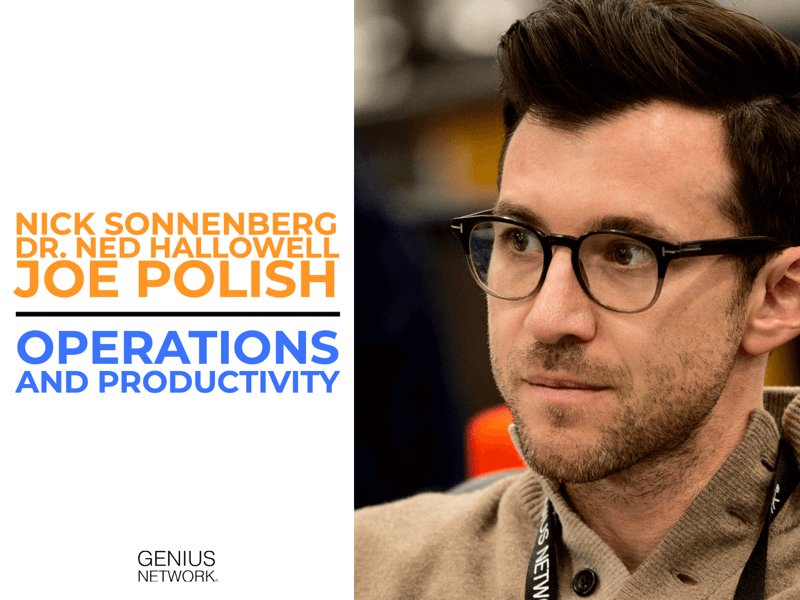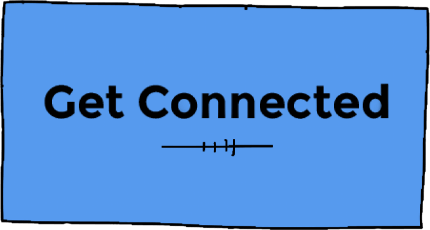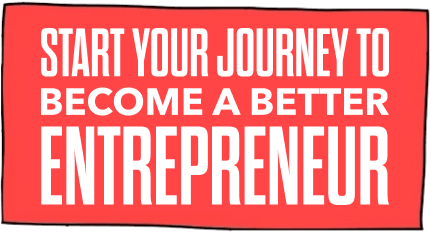
Maximizing Team Efficiency and Effectiveness: Strategies for Improving Communication, Time Management, and Performance with Nick Sonnenberg, Dr. Ned Hallowell, and Joe Polish #187
[mashshare]
Episode Summary
Come Up For Air: How Teams Can Leverage Systems and Tools to Stop Drowning in Work.
If you’d like to join world-renowned Entrepreneurs at the next Genius Network Event or want to learn more about Genius Network, go to www.GeniusNetwork.com.
Here’s a glance at what you’ll discover from Nick, Ned and Joe in this episode:
- Attention Deficit Disorder (ADD) is better described as Variable Attention Stimulus Trait (V.A.S.T.)
- Two quick wins for every business: teaching how to use email properly and improving meetings
- Three ways to increase capacity: hiring more people, telling people to work harder, and getting more out of people and making them more efficient
- Fixing messy email
- Get Nick’s Book Here
- Watch YouTube video Here
WHAT'S IN IT FOR THEM?
Get the first chapter for FREE and a limited-time viewing of "Connected: The Joe Polish Story"
Show Notes
- The main focus of the book is teaching the theory of different communication tools and their purpose (e.g. email, text, Slack, Asana)
- Two quick wins for businesses: proper email usage and organized meetings
- Meetings are currently done poorly, but have the potential to be fantastic
- Mention of Dr. Edward Hallowell’s book “ADHD 2.0”
- Mention of a book by Nick for optimization and productivity.
- Leverage is a training and consulting firm that helps businesses and teams improve efficiency
- They help train people in best practices for tools such as Slack, Asana, and email with the goal of saving up to a business day a week
- The company has helped individuals reduce the number of emails in their inbox and save hours each week
- The target audience is mainly entrepreneurs and business owners who use email as a tool for conducting business.
- Attention Deficit Disorder (ADD) is a misnomer and is better described as Variable Attention Stimulus Trait (V.A.S.T)
- People with V.A.S.T. have an abundance of attention, but challenges in controlling it
- V.A.S.T. individuals are driven by curiosity and a constant need for stimulation and can’t tolerate boredom
- Entrepreneurs with V.A.S.T. are easily distractible and often quick to act without setting up systems
- Email presents a constant distraction with its never-ending stream of messages and the fear of missing out
- The constant communication and stimulation leads to “screen sucking” and addiction to technology
- The algorithms of platforms like Instagram and Facebook are becoming more advanced and can easily distract individuals
- The current era offers more opportunities for distraction than ever before.
- Problem with modern technology and the ease of access to people and information
- Nick has ADHD and developed content and frameworks to help solve his own struggles with ADHD
- Difficulty in being present and having too many ideas and tasks to keep track of
- David Allen’s quote “Your brain is for having ideas, not holding ideas”
- Need to have a place to organize and dump ideas to avoid being overwhelmed
- GTD (Getting Things Done) methodology for organization and management
- Author used to be organized with email using GTD in the past but lost organization when switching to Mac
- Common complaints of entrepreneurs: overwhelm, not achieving their goals, more to do than time to do it, and lack of capacity.
- Biggest problem with tools like email: people don’t know the purpose of the tool and when to use it.
- Two quick wins for every business: teaching how to use email properly and improving meetings.
- Knee-jerk reaction to increase capacity: hiring more people, which is the most expensive strategy.
- Three ways to increase capacity: hiring more people, telling people to work harder, and getting more out of people and making them more efficient.
- Fixing messy email: reducing the number of entries from 280,000 to 0 in a few hours.
- People have too many folders, which results in wasted time and lost productivity
- Instead of using folders, using the search bar is faster
- The cost of dragging an email into a folder can add up to 8 hours in a year for one person and 80 hours for 10 team members
- There’s no need to delete emails as there is ample cloud storage to archive them
- Every decision, even to delete or ignore an email, takes a certain amount of brain power
- If there’s too many emails, the person may have to make too many decisions leading to a more drastic solution
- The goal is to have an “inbox zero” where anything not relevant to the present moment is archived
- The RD framework – Reply, Archive, Defer – is introduced
- Deferring an email can be done with a snooze feature, which bounces the email back to the top of the inbox on a certain date
- Deferred emails can also return to the top if there’s an update
- The snooze feature is useful for follow-up emails or for scheduling certain types of work for specific days of the week.
- Focus on reducing inbox to zero
- Suggestions for Gmail settings: enable reply all as default, enable auto advance
- Keyboard shortcuts: “E” for archive, “C” for categorized, “L” for later
- Anything to be dealt with today should stay in the inbox
- Archive emails that are not needed
- All emails including archived ones can be found in “all mail”
- Separate competence from self-esteem
- The purpose of the book is to help with learning
- Quickest thing to do is understand the purpose of email and separate personal and external communication
- Start with solving one problem at a time, e.g. email
- Book can be found at what’sinitforthem.com or joesfreebook.com
- Aim is to give confidence and capability and a different perspective on ADHD





